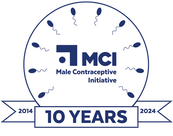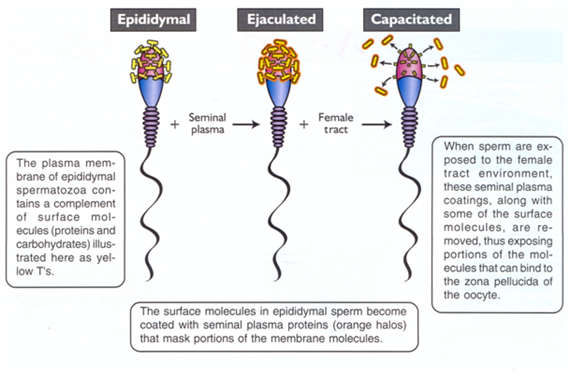|
(Source: Ferenc Husvéth) Capacitation, generally speaking, is the change sperm undergo in the female reproductive tract that enables them to penetrate and fertilize an egg. This step is a biochemical event; the sperm moves normally and looks mature prior to capacitation. It is important to note that once the sperm reaches the egg, it does not mean that it is capable of fertilizing it immediately. In order to fertilize the egg, the sperm must undergo the process of capacitation in the reproductive tract where a number of enzymes and signaling molecules are involved. This process can take around 10 hours, which means that the fertilization time is approximately 24 hours. Capacitation causes a series of changes in sperm’s biochemical composition and structure such that they develop increased motility and are prepared for interactions with the egg (or oocyte) at fertilization. Essentially, the sperm becomes able to break through the membrane (known as the zona pellucida) that surrounds the egg. Once sperm is able to traverse the zona pellucida, it can begin the process of fertilizing the egg. It is also important to consider the two distinct types of fertilization when thinking about capacitation and how it occurs:
Nuts & Bolts: Capacitation To learn more about, please visit our series of posts about male reproduction and contraception: Key terms: Albumin - a protein made by your liver that helps keep fluid in your bloodstream so it doesn't leak into other tissues. Albumin also carries various substances throughout your body, including hormones, vitamins, and enzymes. Biochemical - relating to the chemical processes and substances which occur within living organisms. Conception - the process of becoming pregnant involving fertilization or implantation or both. Ejaculation - the action of ejecting semen from the body. Endocrine System - a chemical messenger system consisting of hormones, the group of glands of an organism that secrete those hormones directly into the circulatory system to regulate the function of distant target organs, and the feedback loops which modulate hormone release so that homeostasis is maintained. Enzyme - a substance produced by a living organism which acts as a catalyst to bring about a specific biochemical reaction. Epididymis - a highly convoluted duct behind the testis, along which sperm passes to the vas deferens. In vitro fertilization - process of fertilisation where an egg is combined with sperm outside the body. In vivo fertilization - fusion of sperm with egg occurs within the body of a female. Lipoprotein - any of a group of soluble proteins that combine with and transport fat or other lipids in the blood plasma. Oocyte - a cell in an ovary which may undergo meiotic division to form an ovum. Spermatozoa - the mature motile male sex cells of an animal, by which the ovum is fertilized, typically having a compact head and one or more long flagella for swimming. Zona pellucida - the thick transparent membrane surrounding a mammalian ovum before implantation. For additional terminology related to male contraception and the male reproductive system, please visit our glossary: Sources/References: Johnson MH (2007). Essential reproduction (6th ed.). Malden Massachusetts: Blackwell Scientific Publications. pp. 177–178. ISBN 978-1-4051-1866-8. Okabe M (2013). "The cell biology of mammalian fertilization". Development. 140 (22): 4471–4479. doi:10.1242/dev.090613. PMID 24194470. S2CID 2015865. Visconti PE, Galantino-Homer H, Moore GD, Bailey JL, Ning X, Fornes M, Kopf GS (1998). "The molecular basis of sperm capacitation". Journal of Andrology. 19 (2): 242–248. doi:10.1002/j.1939-4640.1998.tb01994.x (inactive 2021-01-10). Puga Molina LC, Luque GM, Balestrini PA, Marín-Briggiler CI, Romarowski A, Buffone MG (2018). "Molecular Basis of Human Sperm Capacitation". Frontiers in Cell and Developmental Biology. 6: 72. doi:10.3389/fcell.2018.00072. PMC 6078053. PMID 30105226. Lybaert P, Danguy A, Leleux F, Meuris S, Lebrun P (2009). "Improved methodology for the detection and quantification of the acrosome reaction in mouse spermatozoa". Histology and Histopathology. 24 (8): 999–1007. doi:10.14670/HH-24.999. PMID 19554507. Chang MC (1951). "Fertilizing capacity of spermatozoa deposited into the fallopian tubes". Nature. 168 (4277): 697–698. Bibcode:1951Natur.168..697C. doi:10.1038/168697b0. PMID 14882325. S2CID 4180774. Visconti PE, Bailey JL, Moore GD, Pan D, Olds-Clarke P, Kopf GS (April 1995). "Capacitation of mouse spermatozoa. I. Correlation between the capacitation state and protein tyrosine phosphorylation". Development. 121 (4): 1129–37. PMID 7743926. Visconti PE, Moore GD, Bailey JL, Leclerc P, Connors SA, Pan D, Olds-Clarke P, Kopf GS (April 1995). "Capacitation of mouse spermatozoa. II. Protein tyrosine phosphorylation and capacitation are regulated by a cAMP-dependent pathway" (PDF). Development. 121 (4): 1139–50. PMID 7538069. For additional publications related to male contraception and the male reproductive system, please visit our publications page:
7/10/2021 08:43:24 am
Amazing blog, I'm very happy to read this blog. Basically, I know new many things to read this blog. I strongly believe that the blog delivers the best information to its audience. Comments are closed.
|
Categories
All
Archives
June 2024
|
|
|
Donate to Male Contraceptive InitiativeYour generous donation makes a difference!
|
© Male Contraceptive Initiative. All rights reserved.


 RSS Feed
RSS Feed
